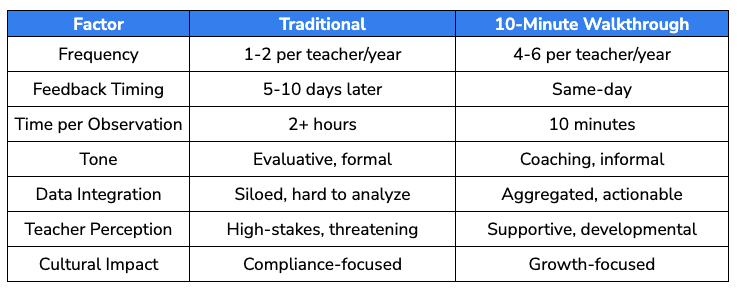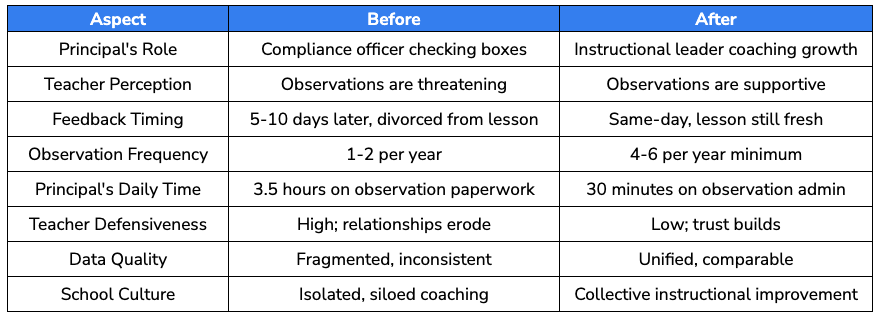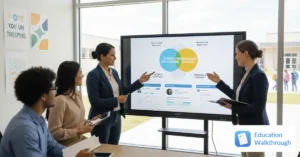And yet, time isn’t even the worst part. The traditional model leaves educators feeling observed, not supported, and that’s where the real breakdown begins.
The Feedback Lag Problem
You observe a lesson on Monday. The teacher doesn’t get feedback until Friday. By then, the energy and detail of that moment have faded. The nuances of how questions were asked or how students responded are lost.
This delay transforms a coaching opportunity into a compliance task. Teachers feel this gap.
Instead of growth-oriented conversations, feedback starts to feel evaluative and impersonal. It erodes trust and stalls progress. In reality, timely feedback, delivered within hours, not days, keeps the instructional coaching communication alive and meaningful.
The Consistency Crisis
Across districts, principals and coaches often rely on different templates, tools, and terminology. This fragmentation means feedback quality varies widely, and data becomes nearly impossible to compare or aggregate.
Without consistent systems, identifying trends or planning targeted professional learning turns into guesswork. Schools end up spending resources on training that misses the real needs of their teachers.
The Frequency Trap
Most schools still conduct just one or two formal observations a year. Far too few to drive real improvement.
Research shows that frequent, bite-sized coaching cycles produce stronger, faster teacher growth. When leaders can capture small snapshots of instruction more regularly, they create a culture of continuous improvement rather than one-off evaluations.
Why Leaders Burn Out
These broken systems hinder teacher growth and exhaust leaders. Principals and coaches spend hours chasing paperwork instead of mentoring their teams.
They’re forced to juggle compliance demands with instructional leadership, and that imbalance drains morale. With more efficient feedback tools and streamlined observation workflows, leaders can refocus their time on what matters most —developing teachers and strengthening school culture.
What If You Could Coach Every Week Instead of Every Year?
The 10-minute walkthrough flips this entirely.
It’s not just a shorter observation. It’s a fundamentally different approach that prioritizes actionable coaching over compliance.
Consider professional athletes. A tennis player receives focused feedback from a coach in just five minutes, then practices before the next check-in. The frequent, targeted guidance drives measurable improvement.
Teachers rarely get this kind of support in schools.
The Shift
Instead of:
- 1-2 comprehensive observations per teacher per year
- Feedback delivered 5-10 days later
- High-stakes, evaluative tone
You get:
- 2-3 brief walkthroughs per week, capturing real instructional moments
- Same-day, actionable feedback that can be applied immediately
- Low-stakes, supportive coaching tone that encourages experimentation and growth
The impact: Over a month, 8-12 different teachers are observed, and over a year, each teacher receives 4-6 observations with in-the-moment feedback.
The built-in timer signals that this is brief, informal, and supportive rather than evaluative.
The tone shifts. Trust and engagement start to build.
How This Actually Works
The 10-minute walkthrough is structured, simple, and highly effective.
Phase 1: Prep (5 minutes)
Preparation is key; never forget that.
- Identify one focus area (e.g., student behavior and engagement, teacher wait time, or group work participation).
- Set a timer for 10 minutes.
- Inform the teacher casually about the walkthrough and focus area. For example, “I’m going to pop into your room for about 10 minutes. I’m looking at how students engage with group work today.”
Phase 2: In the Classroom (2 minutes)
The classroom walkthrough is where the work really happens.
- Sit at the back and observe the specific behavior.
- Capture evidence, notes, photos, or student work, without evaluating.
- Avoid judgments; record factual observations only. For example, “The teacher waited five seconds after asking a question. Two students raised their hands without being called on. No off-task behavior.”
- Take a photo of the student’s work. This is optional but very helpful.
- Ten minutes. Timer goes off. You leave.
Phase 3: Organize Your Notes (5 minutes)
While it’s fresh, organize your observation.
- Use a structured classroom observation checklist or template to organize your observations.
- Tag notes to your school’s rubric.
- Attach any supporting evidence, such as photos.
Phase 4: Write One Powerful Note (3 minutes)
This is not a comprehensive teacher evaluation.
- Focus on one positive action the teacher performed.
- Explain what you say, why it matters, and suggest next steps.
- Keep it specific, affirming, and actionable.
Here is an example:
“I noticed you paused for about five seconds after asking ‘Why do you think the colonies were divided on this issue?’ before calling on anyone. Two students raised their hands without being prompted. Wait-time signals you value thoughtful responses and gives all students time to develop ideas. I’d like to see you apply this same pause technique in Cold Call routines tomorrow.”
Phase 5: Same-Day Delivery
Make sure the feedback is fresh with same-day delivery.
- Our Education Walkthrough app formats your note into a professional feedback email.
- Send it to the teacher, ideally before the final bell.
- The teacher receives feedback while the lesson is fresh, enabling immediate application.
Phase 6: Brief Check-In (Optional, within 1 week)
A quick check-in is always helpful.
- Conduct a 3-5 minute hallway or Slack check-in.
- Ask reflective questions (e.g., “How did that work?”).
- Affirm progress and offer refinements if needed.
Scaling Across Your School
Start small, but scale later.
- A principal can conduct 2-3 walkthroughs per week.
- Over 4 weeks: observe 8-12 teachers.
- Over a year: ensure every teacher receives 4-6 observations with same-day feedback.

High-frequency walkthroughs build trust, increase visibility, and foster a supportive coaching culture.
Why This Actually Works (The Data)
With over 50,000 walkthroughs in 700+ school districts, the results are clear and measurable.
Key outcomes observed:
- Educators reclaim an average of 5 hours per week, totaling 250+ hours annually.
- Feedback that used to take 4 days is now delivered within 10 minutes, keeping it timely and actionable.
- Over 15,000 teachers now receive immediate, constructive feedback.
- Case studies show teachers improve rapidly: “Teachers Started Getting Better 24x Faster.”
Benefits of regular coaching and walkthroughs:
- Teachers respond positively because feedback is immediate and focused.
- Observation data highlights patterns that inform targeted professional development.
- Instructional coaching shifts from evaluation to collaboration, strengthening trust.
- Continuous presence allows leaders to proactively support teachers rather than reactively correct issues.
- Over time, school-wide culture improves as feedback becomes routine and embedded in daily practice.
Common Objections (And Why They Don’t Hold Up)
Objections are expected when it comes to effective change.
“Isn’t 10 minutes too short?”
A partial observation of one specific skill is more actionable than a comprehensive class observation, such as the Danielson Rubric, where you try to evaluate four domains at once.
The goal is a coaching moment, not a summative evaluation. Specific evidence beats comprehensive data every time.
“Won’t teachers resent frequent observations?”
Actually, the opposite happens.
Infrequent, high-stakes observations create anxiety. Frequent, low-stakes observations build trust.
When walkthroughs become normal across all teachers, not targeted at “struggling” ones, the tone shifts entirely. It becomes supportive, not threatening.
“What about teachers who are actually underperforming?”
10-minute walkthroughs complement formal evaluation. They don’t replace it.
Frequent coaching provides a support structure and documentation of coaching attempts. This actually strengthens your legal position if an improvement plan becomes necessary.
Teachers under improvement plans receive more coaching, not less. That support is documented. When challenges arise, you have a record of good-faith coaching attempts.
“Can we use our state rubric?”
Yes.
Education Walkthrough includes 51 template types. Customize them to your framework. The methodology works with the T-TESS evaluation cycle, Marzano, Danielson, whatever your school uses.
Framework-agnostic design means no workflow disruption.
“Our district already uses Google Forms.”
Generic tools lack:
- Built-in timers
- Auto-formatting
- Same-day delivery
- Data aggregation
- Mobile optimization
Purpose-built apps save time (5 hours per week) and improve coaching effectiveness. The cost justifies itself within six months through time reclamation alone.
“This adds more meetings.”
The opposite.
Email delivery eliminates lengthy post-conferences. You replace 30-minute meetings with brief follow-ups, such as hallway conversations and Slack messages.
Meeting load decreases. Coaching impact increases.
“Teachers won’t actually change from brief feedback.”
Research on deliberate practice shows that specific + frequent feedback drives change.
Frequency compounds the impact. When you return next week, observing similar elements, real change happens.
Immediacy preserves the coaching window. Teachers can apply feedback to their next lesson while the context is fresh.
“This seems complicated to implement.”
Our Education Walkthrough tool provides 30-day implementation support:
- Week 1: Account setup + template import
- Week 2: Admin training webinar
- Week 3: School-wide launch (company provides teacher training videos)
- Week 4: First data review + Q&A
We also provide training videos, templates, and ongoing support.
For District Leaders: Why This Matters at Scale
If you’re a superintendent or district director, you already know how time-intensive it can be to manage observation data, ensure compliance, and provide effective professional development. The 10-minute walkthrough model, powered by Education Walkthrough, helps you simplify all that, turning observation into insight and insight into impact.
The Compliance Problem
Gathering and organizing observation data for TEA, ESSA, or Title II compliance eats up valuable hours. With Education Walkthrough, aggregated data auto-generates compliance reports in one click.
- Step 1: Collect walkthroughs digitally using standardized forms.
- Step 2: Data auto-populates district dashboards.
- Step 3: Export compliance reports instantly.
No manual compilation. No missed deadlines. You stay audit-ready year-round.
The Data Inconsistency Problem
Comparing walkthrough data from multiple campuses shouldn’t feel like comparing apples to oranges. When all schools use the same templates and system, data becomes clean, consistent, and actionable.
- Identify trends across campuses in seconds.
- Compare engagement, instructional rigor, or classroom management district-wide.
- Use unified insights to direct PD funding where it drives measurable improvement.
The PD Investment Problem
Generic, one-size-fits-all PD wastes both time and money. Walkthrough data helps you pinpoint specific areas of need so professional learning becomes relevant and data-driven.
For example, Washington Latin Public Charter School used walkthrough data provided by the Education Walkthrough tool to reveal a district-wide gap in “student engagement strategies.” They built targeted PD around that focus, improving teacher confidence and student outcomes. When PD is responsive to real data, it sticks.
The Teacher Retention Problem
Frequent, supportive feedback is one of the strongest predictors of teacher retention. 10-minute walkthroughs help leaders give consistent, meaningful feedback that builds trust and professional growth.
Teachers who feel seen and supported stay longer, perform better, and contribute to a stronger school culture. And that stability saves districts thousands in turnover costs.
The Scalability Problem
Scaling instructional support shouldn’t mean scaling complexity. With Education Walkthrough’s district dashboard, you can:
- Push templates and updates to all schools with one click.
- Monitor data trends by school, subject, or grade level.
- Spot performance gaps and address them before they widen.
It’s district-wide visibility without the spreadsheet chaos.
The ROI Conversation
Numbers tell the story best. An ROI calculator projects your time and cost savings.
For example, a district with 20 schools and 30 administrators can see platform costs offset within the first six months. This is thanks to reduced admin time, automated reporting, and better PD alignment.
For Instructional Coaches: Documenting Your Impact
As an instructional coach, your success depends on visible results. The 10-minute walkthrough framework helps you track progress, measure growth, and clearly communicate impact.
Track Progress Over Time
The Growth Tracker feature keeps all action plans, evidence, and next steps organized for each teacher you support.
- Log observations quickly.
- Tag feedback by skill or standard.
- Monitor growth arcs over time.
When someone asks, “What’s your coaching impact?”, you can show it with data-backed evidence.
Evidence-Based Feedback
Every coaching conversation is grounded in real classroom evidence, not memory. Each note, tag, and timestamp connects feedback directly to practice.
Teachers see feedback that’s focused, fair, and actionable. That transparency strengthens relationships and accelerates improvement.
Data-Informed Focus
Instead of guessing where to spend your time, aggregated observation data highlights the instructional priorities that need attention.
- Identify common coaching needs across teams.
- Prioritize your time on high-impact areas.
- Track results as teachers grow.
It’s strategic coaching made visible and achievable in just 10 minutes a day.
The Transformation: From Compliance to Coaching Culture
Here’s what actually changes:

What Becomes Possible
When a school makes this shift:
- Teachers see principals differently. Not as evaluators. As partners invested in their growth.
- Principals reclaim their role. They lead. They’re visible in classrooms. They coach. They make a difference.
- Feedback actually lands. Because it arrives when it matters—same day, specific, actionable.
- Professional development aligns. Data reveals what teachers actually need. PD gets targeted.
- Culture changes. Instructional improvement becomes the norm, not the exception.
Getting Started: A Realistic Roadmap
Taking one step at a time ensures your rollout feels manageable and sets everyone up for success. Here’s a concrete plan you can actually follow.
Week 1: Pilot Phase
The first phase sets the stage:
- Step 1: Choose three leaders, typically a principal and two instructional coaches, to test the process.
- Step 2: Each leader completes 1–2 walkthroughs per week.
- Step 3: Meet briefly to share first impressions, challenges, and wins. Document early patterns and note how teachers respond.
Weeks 2–4: Feedback Loop
Review and provide feedback to optimize teacher engagement.
- Step 1: Review what worked and what didn’t. What trends are emerging?
- Step 2: Refine your feedback approach, clarify expectations, simplify forms, or adjust focus areas.
- Step 3: Continue walkthroughs and monitor teacher engagement. Use data from the app to guide next steps.
Month 2: Expand
Here is where you grow and expand.
- Step 1: Introduce the process to your full leadership team.
- Step 2: Increase to 2–3 walkthroughs per person per week.
- Step 3: Build team norms around frequency and consistency. Use data meetings to celebrate growth and align on next focus areas.
Month 3+: Sustain
Maintaining the strategy of walkthroughs helps set you and your school up for success.
- Step 1: Make walkthroughs part of your leadership rhythm, something expected, not extra.
- Step 2: After 20–30 observations, review aggregated data for trends.
- Step 3: Translate insights into targeted professional development or coaching cycles.
Celebrate Wins
Recognize progress publicly when teachers apply feedback effectively, when leaders hit milestones (like 50 walkthroughs), and when patterns begin to shift instructionally. These small celebrations fuel momentum and reinforce a culture of growth.
Bottom line: Start small, stay consistent, and let data guide your next move. Within weeks, you’ll see the shift from initiative to habit.
What Success Looks Like
Here’s what you can expect.
In 90 Days:
- The leadership team has conducted 100+ walkthroughs
- Teachers report seeing principals in classrooms regularly
- Feedback delivery time drops dramatically
- Early adopters notice teachers applying feedback more quickly
In Six Months:
- Every teacher has received multiple observations with same-day feedback
- Aggregated data reveal school-wide instructional needs
- Professional development shifts to data-informed targets
- Principal time saved: 5+ hours per week
- Teacher retention improves
In a Year:
- Coaching becomes normal, not exceptional
- Culture has shifted from evaluative to developmental
- Observation data informs strategic decisions
- District leaders see the model working and scale it
Your Frequently Asked Questions
Have questions? We’re happy tp help!
Can our school customize templates to match our rubric?
Yes. The platform includes 51 template types. Customize to T-TESS, Marzano, Danielson, or your own framework.
How long does implementation take?
30 days from signup to full school adoption. Week 1 is setup. Weeks 2-4 bring everyone on board.
What if we have very limited time?
Even one walkthrough per week per principal adds up. Start there. Build the habit. Increase frequency as you get comfortable.
Does this work for remote or hybrid teachers?
Yes. Walkthroughs can be conducted in person or during synchronous virtual instruction.
What about teachers on improvement plans?
Frequent coaching provides documentation and support. It actually strengthens your legal defensibility during formal improvement processes.
Ready to Transform How You Coach?
The 10-minute walkthrough isn’t just a time-saving hack. It’s a fundamental shift in how you think about coaching.
More frequent. More immediate. More human.
Experience the methodology and the power of the Education Walkthrough tool firsthand. No credit card required. Full access to the mobile app and dashboard.
See how it works in your school.


